Michigan grape scouting report – August 13, 2025
Check out the latest Michigan Grape Scouting Report for timely updates on weather, vine growth, disease management, and pest activity. Stay informed and make proactive decisions to support vineyard health and productivity.
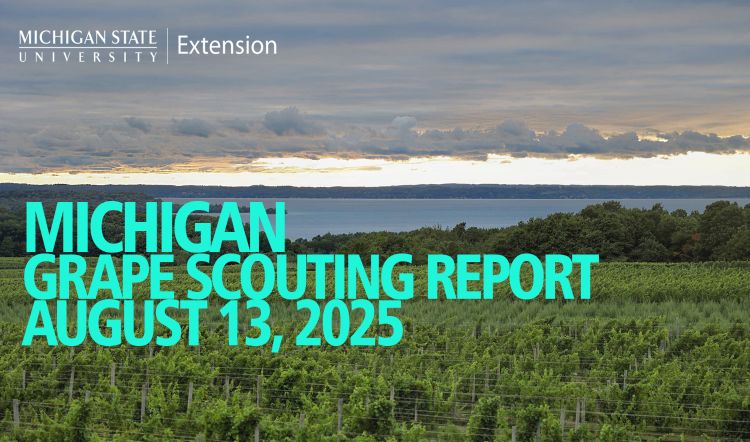
Weather update
Detailed seven-day forecasts for Michigan grape production regions are available below:
- Southwest Michigan: Benton Harbor, Fennville, Lawton
- Southeast Michigan: Romeo
- Northwest Michigan: Old Mission, Petoskey, Traverse City
Agricultural Weather Outlook: Weekly in-season weather updates are provided to the Michigan State University Extension fruit team by Jeff Andresen, Michigan State University (MSU) agricultural meteorologist. These reports offer timely insights into weather conditions affecting fruit production across Michigan.
Growing degree day (GDD) report
Track vine development using the MSU Enviroweather Growing Degree Day (GDD) map. Visit the site to find your nearest weather station, create a free account, and monitor GDDs daily: MSU Enviroweather GDD Tool
Weekly GDD summary (Base 50 F)
The table below summarizes current GDD accumulation, last week's totals, and the weekly increase for each monitored location across Michigan:
|
Location |
Current GDD (Base 50 F) |
GDD Last Week |
Weekly Accumulation |
|---|---|---|---|
|
Benton Harbor (SWMREC) |
2224.1 |
2017.9 |
206.2 |
|
Fennville |
2050.1 |
1855.0 |
195.1 |
|
Lawton |
2179.8 |
1982.2 |
197.6 |
|
Average – Southwest Michigan |
2151.3 |
1951.7 |
199.6 |
|
Romeo |
1996.0 |
1810.4 |
185.6 |
|
Average – Southeast Michigan |
1996.0 |
1810.4 |
185.6 |
|
Old Mission |
1581.3 |
1399.2 |
182.1 |
|
Petoskey |
1515.3 |
1335.8 |
179.5 |
|
Traverse City (NWMHRS) |
1706.9 |
1517.6 |
189.3 |
|
Average – Northwest Michigan |
1601.2 |
1417.5 |
183.6 |
Weather forecast
Southern Michigan reported a cooldown last week with several days below 80 degrees Fahrenheit. Humidity was also low, bringing minimum temperatures into the 50s for the first time in several weeks. A cold front passed through the area on Wednesday afternoon, Aug. 6, bringing the cooler temperatures along with rain. Most areas reported around a half inch of rain. The north winds also brought some significant haze as a result of the Canadian wildfires causing some caution days for workers outside.
Northern Michigan reported a similar trend in temperatures and conditions. Daily high temperatures dropped into the low 70s before rebounding at the beginning of this week. Lows reached into the upper 40s a couple nights. Northern Michigan did not experience any of the rains seen further south.
The forecast is for a gradual warming through the weekend with some unstable air moving through at the beginning of next week. This will potentially result in some minor chances of light rain amounts and slightly lower temperatures towards the beginning of next week. Total rain amounts expected in the next seven days are less than a quarter inch for all grape growing regions.
Vine growth
In southwest Michigan, most hybrids are in the middle of or finishing veraison. Some vinifera are starting to show color as well, mainly burgundian cultivars. The second round of leaf pulling will begin soon in red cultivars. Fruit thinning continues to improve both fruit quality and vine balance. At this stage, the vine has already set its crop, and the decision to remove clusters can be based on a more accurate assessment of crop load, vine vigor and seasonal conditions.
Growers are starting to focus sprays on cluster protection products. Some growers are indicating harvest to begin in two weeks. The National Grape Cooperative has put out their harvest estimates indicating Concord harvest should begin around Sept. 28. No split harvest of Niagara is expected with harvest beginning on Oct. 13 after Concords are complete.
In northern Michigan, grape clusters are currently progressing through modified E–L phenology stages 33. Berry size ranges from approximately 9-10 millimeters (pea size), indicating steady fruit development. In stage 33, berries remain hard and green. For a precise visual reference, consult MSU Extension’s Grape Growth Stages chart.
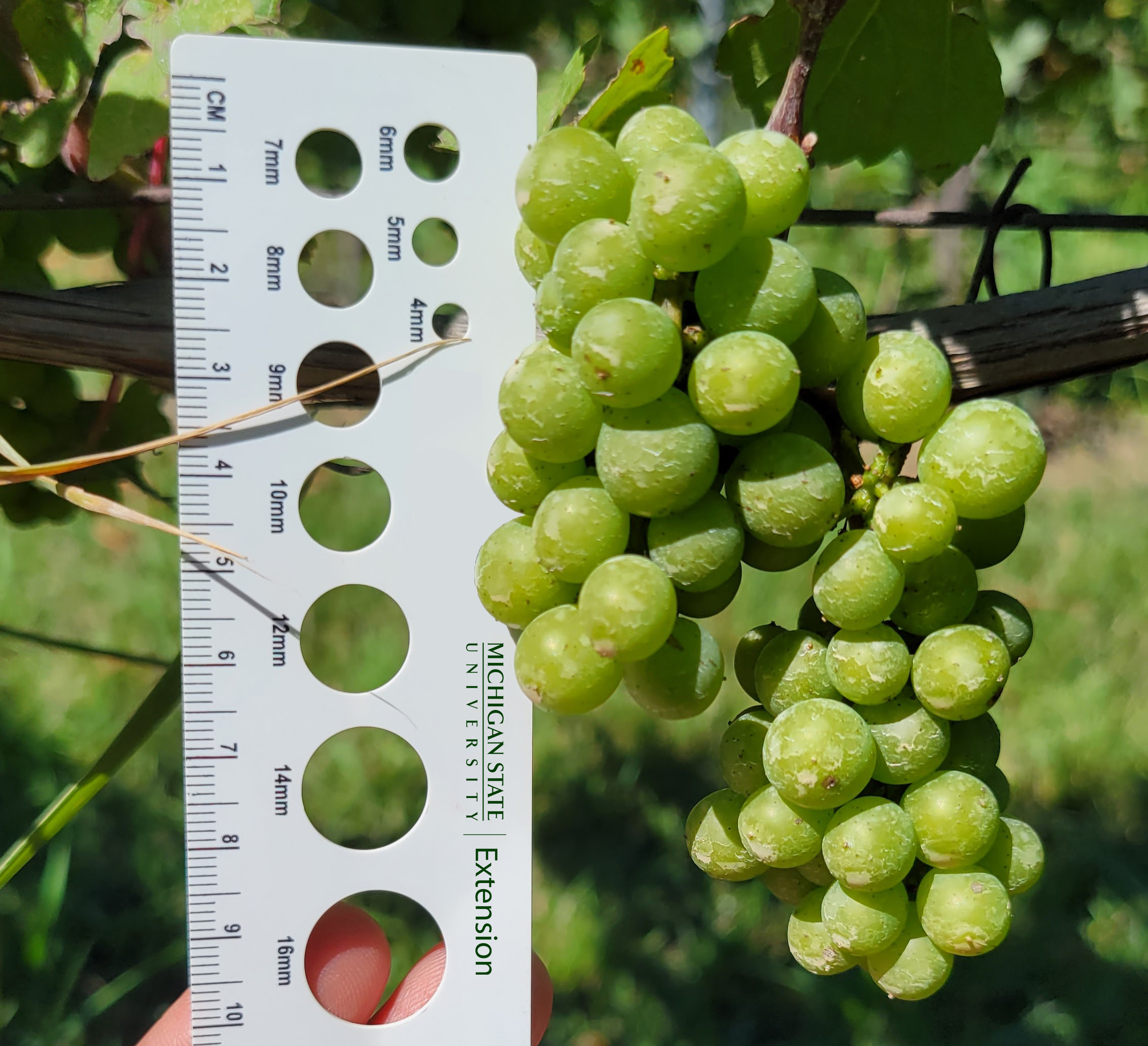
In the Tip of the Mitt American Viticulture Area, hybrid cultivars continue with bunch closure and berry softening. Vitis vinifera cultivars are in the berry touch stage and working toward bunch closure. Ample rainfall, heat and humidity is keeping the risk for black rot, downy mildew and powdery mildew at moderate to high levels.
In southeast Michigan, veraison is well underway. At Kapnick’s in Britton, Michigan, on Aug. 6, Canadice grapes are nearly fully colored. A day later at Verellen’s in Romeo, Michigan, Fredonia grapes showed most berries turned, while at Youngblood’s in Ray Township, Michigan, Frontenac clusters were about 50% colored. Overall, veraison continues across the region, and Marquette harvest is anticipated to begin in approximately two weeks.
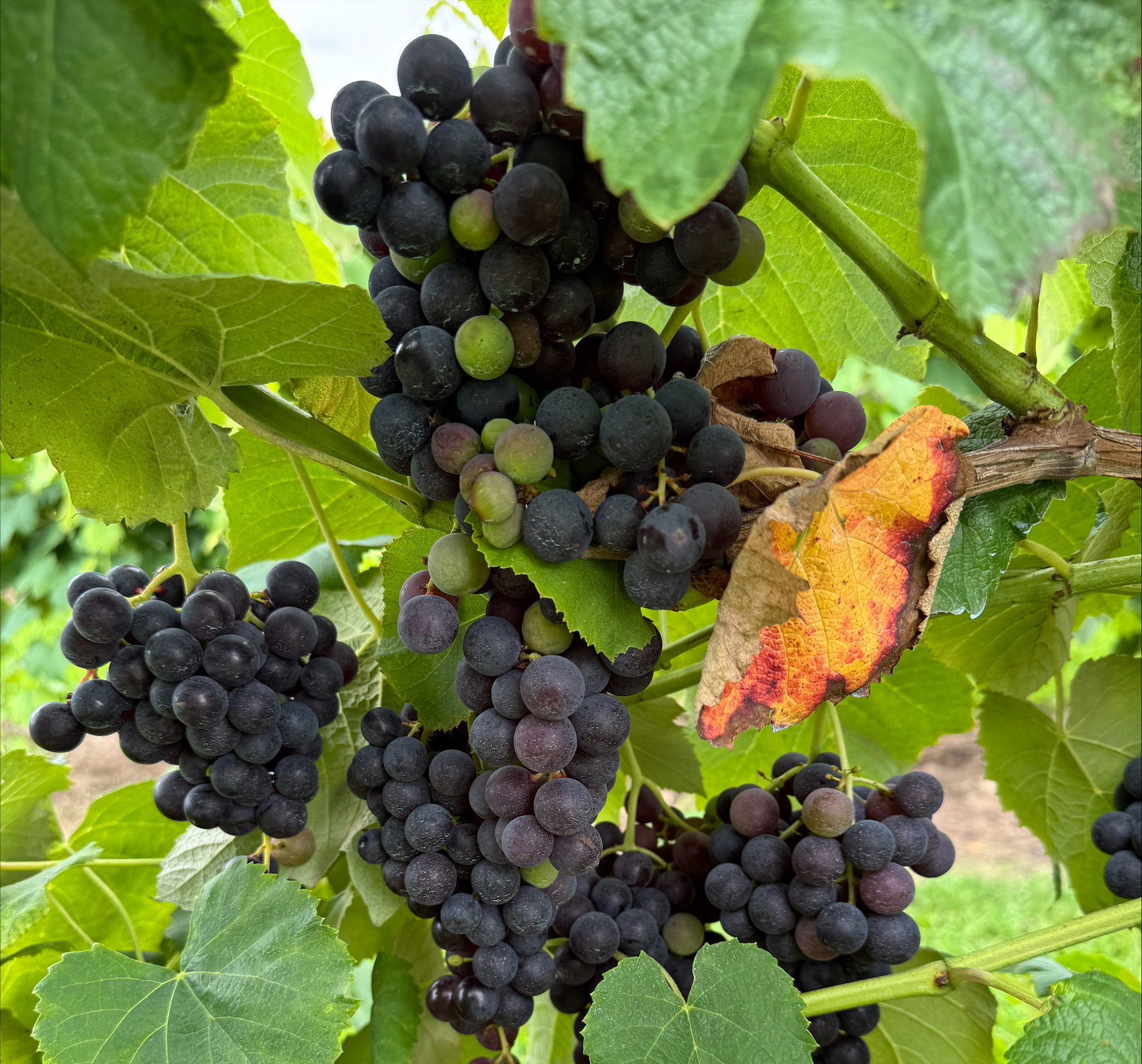
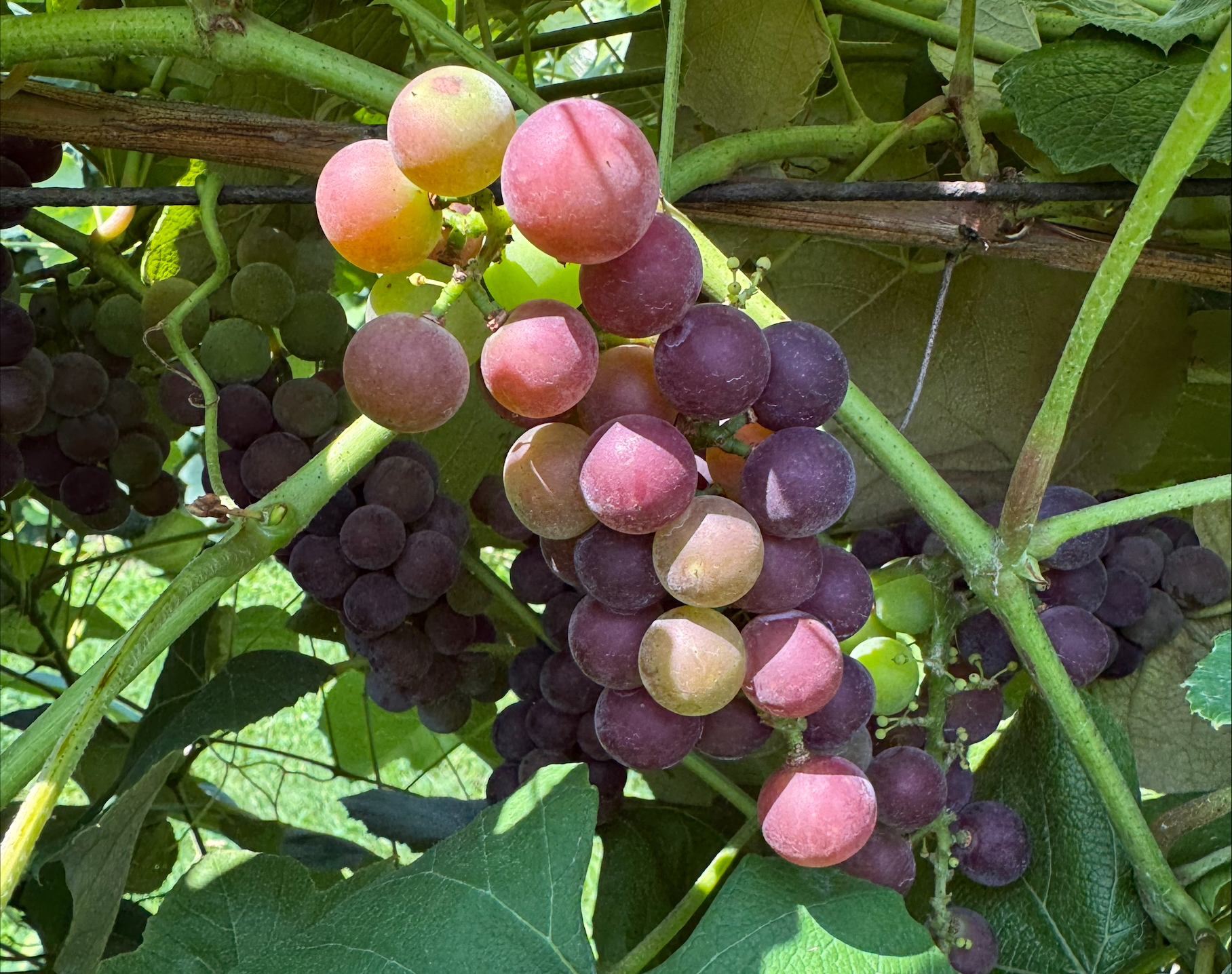

Horticulture
Two vineyard management practices, pre-veraison leaf removal and cluster thinning, are widely applied in Michigan vineyards and used to improve grape and wine quality, particularly in premium wine production. While each technique can deliver quality benefits on its own, research in the Department of Horticulture at MSU has shown that their combined use, when timed correctly, can significantly enhance fruit composition, disease control, and overall vine balance.
Pre-veraison leaf removal
Pre-veraison leaf removal involves removing leaves from the fruit zone when berries begin to change color. The main goals of this technique are to improve sunlight exposure and increase air circulation around the fruit. Studies have demonstrated that this practice can significantly lower the incidence of botrytis and other bunch rots, particularly in tight-clustered varieties. From a physiological standpoint, leaf removal can increase the leaf area-to-fruit ratio and promote more efficient ripening.
In trials at the Southwest Michigan Research and Extension Center, researchers observed an average increase of over 5% in Brix at harvest compared to untreated vines, along with higher concentrations of anthocyanins, flavonols and other phenolic compounds. These improvements in berry chemistry often translate to wines with deeper color, more intense aromas, and improved mouthfeel.
Cluster thinning
Cluster thinning, typically performed at or just before veraison, involves removing a portion of the crop to balance yield with the vine’s capacity to ripen fruit. By veraison, berry size and cluster weight are more predictable, allowing growers to make precise decisions about how much fruit to remove. Research at MSU has shown that reducing crop load at this stage directs the vine’s carbohydrate and nutrient resources to the remaining clusters, resulting in higher sugar accumulation, better color development in red varieties, and more concentrated flavors.
In cool climates, cluster thinning can also help avoid delayed ripening and improve uniformity within and among clusters, which is particularly important in years with variable flowering and set.
The combined effect
When pre-veraison leaf removal and cluster thinning are used together, they can produce a synergistic effect. In cool-climate studies with Cabernet Franc at the Southwest Michigan Research and Extension Center, for example, the combination improved fruit uniformity, boosted anthocyanin accumulation, and advanced ripening more effectively than either practice alone. In warm climates, differences between treatments tend to be smaller by harvest, but early gains in ripening and cluster health are still observed, especially when disease pressure is high. Beyond the vineyard, these practices have been linked to measurable improvements in wine sensory profiles, including more vivid color, greater aromatic intensity, and enhanced structure.
Practical takeaways
The timing and extent of each practice should be adjusted to the specific site, cultivar and seasonal conditions. Pre-veraison leaf removal is best performed pre-bloom or at flowering, before fruit set is complete, to influence berry number and cluster structure or at the beginning of veraison to boost fruit maturation. Cluster thinning is most effective at veraison, when crop load can be evaluated accurately, and the vine’s resources can be redirected to the remaining fruit. Used judiciously and in combination, these tools can help growers consistently produce higher-quality fruit, reduce disease risk and maintain vine health over the long term.
Read more in “Leaf Removal and Cluster Thinning Efficiencies Are Highly Modulated by Environmental Conditions in Cool Climate Viticulture.”
Diseases
In southwest Michigan, disease management of downy mildew, powdery mildew and botrytis fruit rot are the primary focus. The morning dews we will begin to experience are an important reminder to maintain protection against downy mildew. With tight clustered varieties, this is the last chance to get botrytis bunch rot sprays into the tight crevices of the clusters.
In northwest Michigan, disease pressure is still low but continues to increase in specific areas where black rot is becoming more apparent. Black rot symptoms are beginning to show up throughout the state (Photo 6), but it is largely too late to control these infections and fruits will begin to become resistant.
In this growing stage, consider choosing fungicides that control all the foliar and fruit diseases. For example, with downy mildew we are most concerned with foliar infection, and sprays should be timed regularly throughout the season when we experience heavy dews for optimal control. Downy mildew is caused by a fungal-like organism, so many site-specific systemic fungicides that target other spring diseases do not work on downy mildew. Effective fungicides for downy mildew include products in FRAC codes 4, 11, 21, 40 and 45 as well as phosphorus acid salts and some biologically-based products.
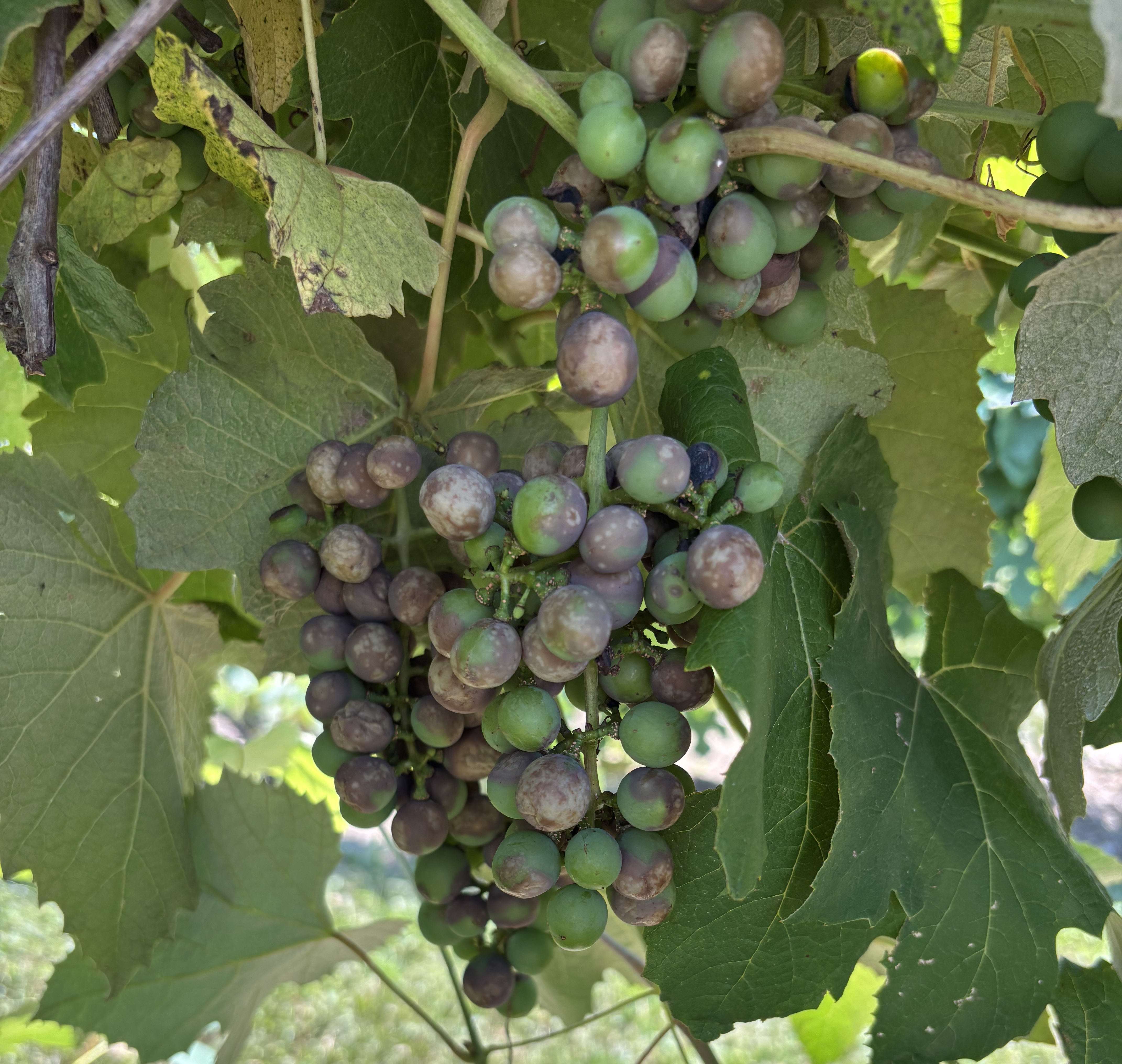
If powdery mildew is the only concern, there are a number of effective products (FRAC codes 3, 7, 11, 13, U8, 50, and U13 as well as sulfur). Combining fungicides from different FRAC classes should also be effective while helping with resistance management.
As we approach bunch closure in southwest Michigan, consider botrytis management. Several strategies contribute to good botrytis bunch rot management including opening up the canopy, properly applying fungicides, and using resistant cultivars when possible. Good botrytis control depends on getting good coverage. Just before bunch closure is the last chance to apply a fungicide to the inner part of the developing cluster. Fungicide resistance management is also important. The most effective products for botrytis are site specific and prone to resistance development. A Michigan Grape Fact Sheet is available for managing botrytis bunch rot.
As you choose a fungicide, check the guide for potential phytotoxicity of certain sprays on Concord grapes especially (this has been particularly noted for fungicides like Revus Top). Phytotoxicity risk is higher with high temperatures and quickly growing vines. Also, there is a significant phytotoxicity risk with specific contact products such as copper and sulfur for Labrusca type grapes (Concord and Niagara).
Insects
Vineyards we are scouting in southwest Michigan indicate fairly effective control of the pre-veraison activity of grape berry moth so far this season. This third generation of this pest continues through August, so continued protection of clusters against grape berry moth is important in high pressure areas. The grape berry moth larvae we found in the last week were the small first instar stage indicating a few who survived the recent sprays. We are also keeping eyes open for the potential for a fourth generation of grape berry moth based on the weather conditions the rest of this month and the timing of the third generation.
With veraison spreading across southwest Michigan, be alert to the risk of sour rot. Stay alert to the development of rots in high-risk vineyards, sites where berry splitting has been happening from recent rains, and if the weather conditions stay hot through the day and night this fall. Also watch out for vinegar flies, as these are the vectors of sour rot pathogens and can make the infestation much worse by spreading them between clusters.
Some of the sites we are monitoring are also showing slight increase in grape leafhopper activity. These were very low and well under thresholds, but this is another insect to be looking for in late summer.
SAM Tool helps you meet Worker Protection Standard requirements
Did you know? One of the many practical features of the Sustainable Agriculture Management (SAM) Tool is its ability to generate a printable PDF of each pesticide application task.
This printout can be posted at a central display location to meet the U.S. Environmental Protection Agency’s Worker Protection Standard (WPS) requirements—keeping your workers informed about recent sprays, restricted entry intervals and treated areas. It can also be handed out as task instructions, especially useful for workers who prefer not to read task instructions in the SAM Tool mobile app on their phones.
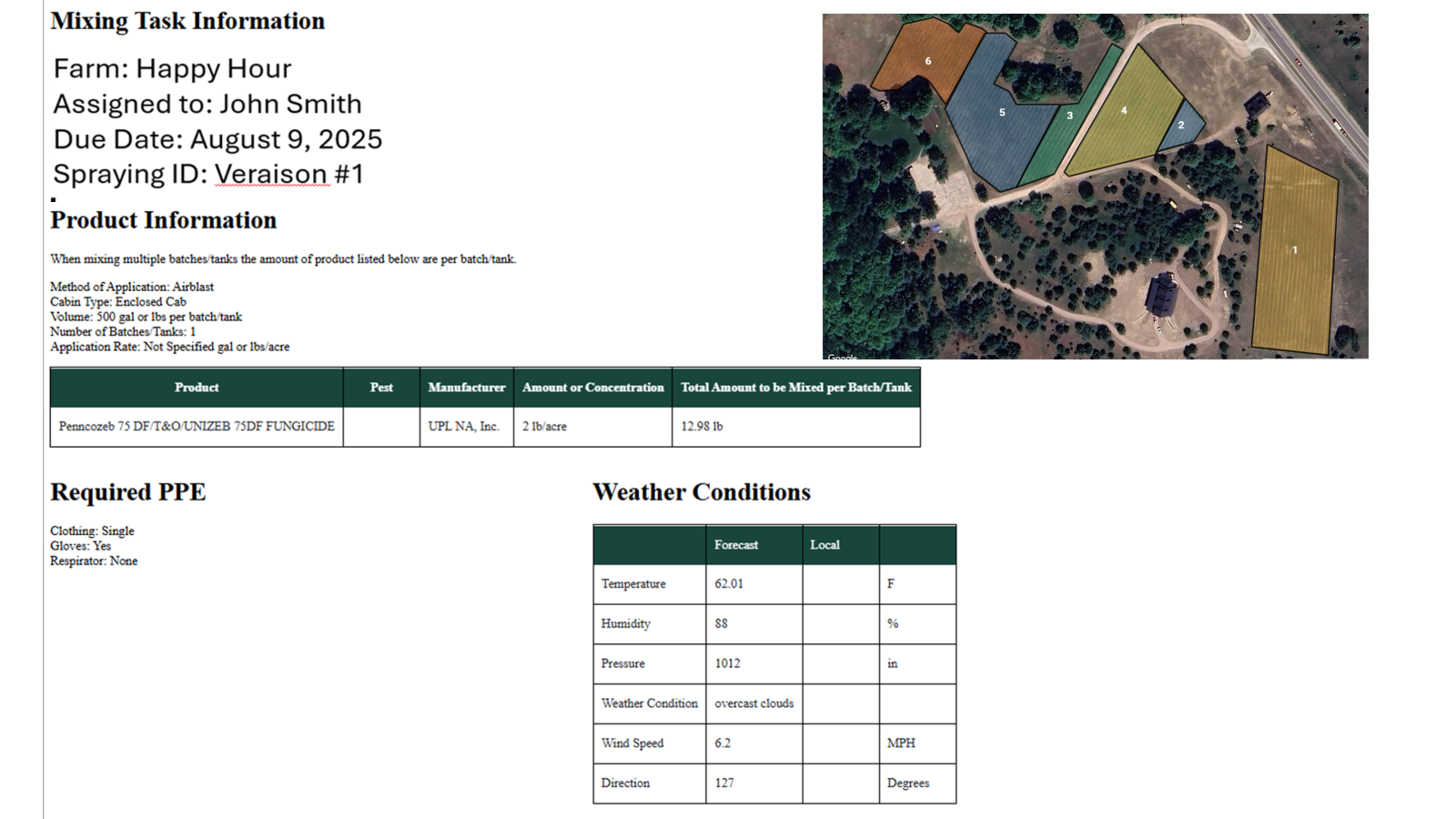
Simple, compliant and worker-friendly—that's the SAM Tool advantage. If you have questions, want help getting started or have suggestions for improvement, please contact us at https://sustainableag.msu.edu/ or reach out to Karen Chou directly at chouk@msu.edu. Let’s keep building the SAM Tool together!
Last call to join us at Party on the Piazza — volunteers needed!

Don’t miss Party on the Piazza next Thursday, Aug. 21, from 5-9:30 p.m. at the Grand Traverse Commons—a relaxed, festive evening bringing together friends and colleagues from across Michigan’s wine and grape industry.
One of the evening’s highlights will be a Georgian wine tasting led by Nino Sachaleli, PhD, a visiting expert from the Republic of Georgia, who will share wines and stories from one of the world’s oldest winemaking traditions.
We’re still looking for a few volunteers to help with setup, wine pouring and event coordination. If you can lend a hand, please sign up by Aug. 15. Your help will make a big difference in making this event a success.
Guests are also invited to bring a bottle of their own wine to share. Let’s make this a memorable celebration of wine, culture, and connection.
Upcoming events
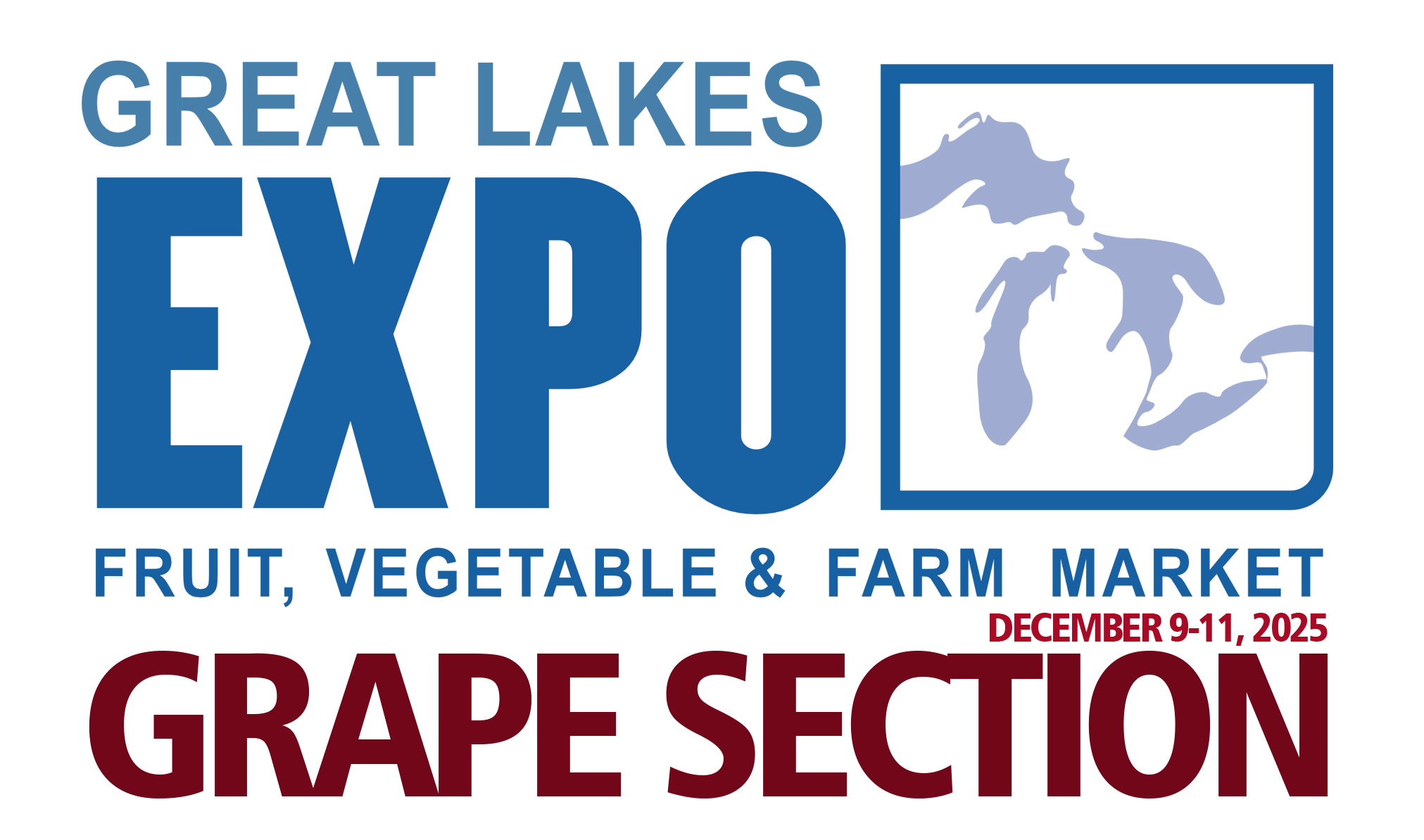
2025 Great Lakes EXPO – Grape Session
Join us at the 2025 Great Lakes Fruit, Vegetable & Farm Market EXPO, happening Dec. 9–11 in Grand Rapids, Michigan.
This year’s grape session will bring together growers, researchers and industry experts to explore the latest in vineyard management, disease control, varietal updates and innovative technologies tailored for the Great Lakes region.
Whether you're new to grape growing or a seasoned professional, this session offers practical insights, valuable connections, and tools to help you grow smarter.
Don't miss it—visit the Great Lakes EXPO website to register and join us in December!
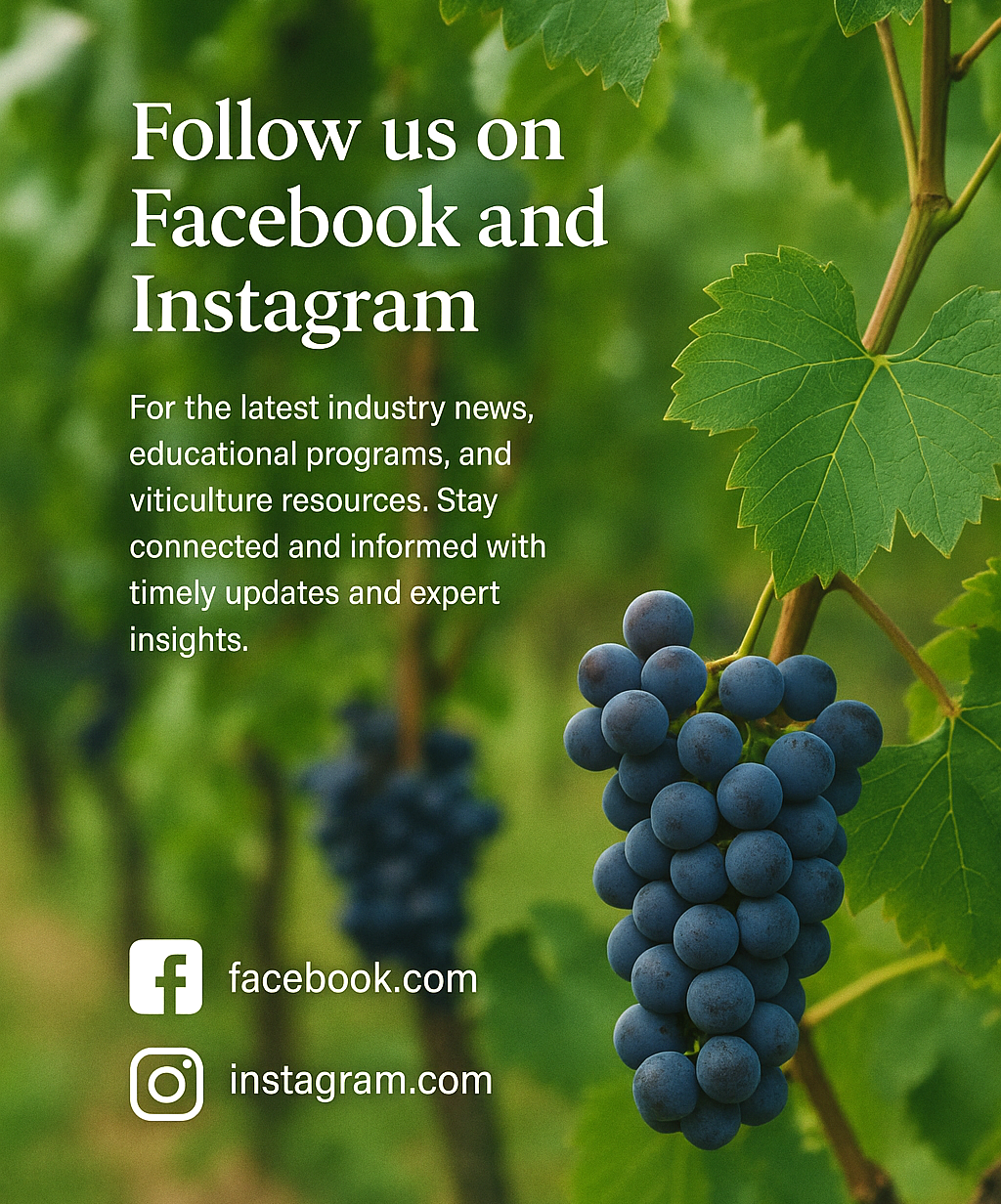
Follow us on Facebook and Instagram for the latest industry news, educational programs and viticulture resources. Stay connected and informed with timely updates and expert insights.
Related articles
- Early hedging for healthier canopies and better ripening in cool climates
- Fruit insecticide registration update for 2023
- Michigan grape scouting report – June 15, 2022
- MSU Fruit Pest Management Guide (E-154)
- Grape growth stages
- A Mobile Guide for Grape IPM Scouting in North Central and Eastern U.S.
- Using the MSU Enviroweather grape berry moth model in 2018



 Print
Print Email
Email